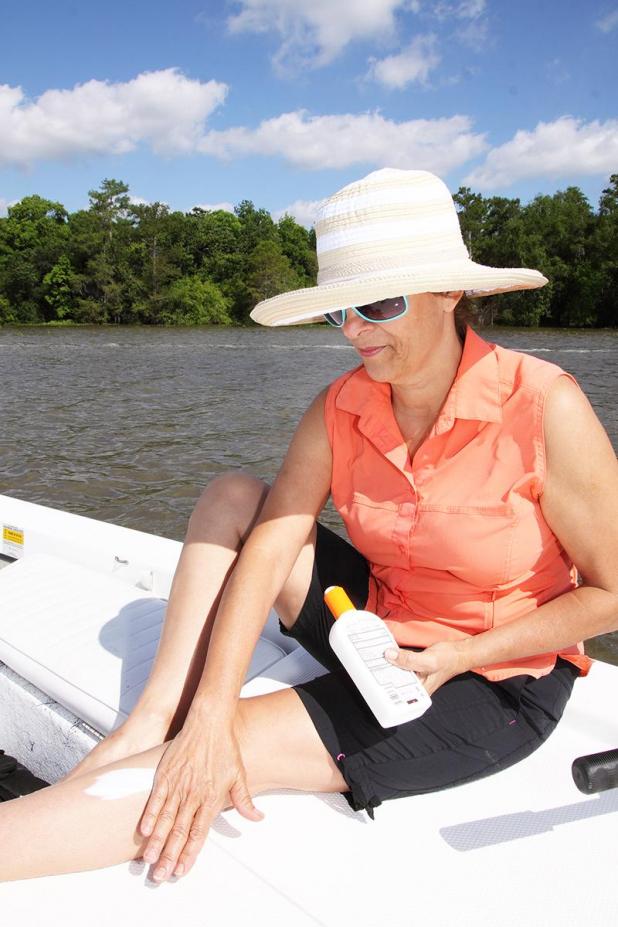
Applying the right amount of sunscreen is critical during the hot summer months. Above, is Christine Flores, wife of The Daily Review Outdoor Writer John Flores. (Submitted Photo/Courtesy of John K. Flores)
Tips to beat the summer heat
While driving to work this past week, I noticed the temperature shortly after 7 a.m. was already 88 degrees at Kemper Williams Park.
On the way, I passed a couple fellas towing a bay boat who obviously were heading to the landing. Though I was going to work and they were heading out for some recreation, we both were going to be experiencing a really hot day with heat indexes easily surpassing 100 degrees.
There is a plethora of information available from the U.S. Department of Labor’s Occupational Safety and Health Administration that is work related but can be used as guidance when out on the water fishing or boating.
Take the heat index, for example. It was developed by the National Oceanic and Atmospheric Administration, or NOAA, to help determine the risk of heat-related illness for outdoor workers. One thing for sure and you can ask any angler, particularly those who fish saltwater if at the end of a full day on the water they’re not tired and worn out from the heat.
What’s interesting is NOAA developed the index values for shaded conditions and light winds. One of the important considerations, as noted by NOAA, is under full sunshine, the heat index can increase up to 15 degrees Fahrenheit. That’s significant, because when you’re fishing Locust Bayou, Pelligrin Cut or Old Oyster Bayou down around Point Au Fer Island, it’s all sunshine.
Essentially, when the heat index is less than 91 degrees Fahrenheit, your risk level is low. When the heat index is 91 degrees Fahrenheit to 103, the risk is moderate. You need to take start taking precautions. The level of risk gets more dangerous when the index is 103 degrees Fahrenheit to 115 degrees Fahrenheit. And when it’s greater than 115 degrees Fahrenheit, it’s extremely dangerous.
The National Institute for Occupational Safety and Health, or NIOSH, is an excellent resource to obtain tips for dealing with heat stress. According to the NIOSH Fast Facts bulletin, heat stress can be caused by exertion or hot environments.
When fishing coastal Louisiana in the summer, you’re exerting yourself “and” doing it in a hot environment.
Some of the symptoms of heat stroke the Fast Facts bulletin includes are high body temperature; confusion; loss of coordination; hot, dry skin or profuse sweating; a throbbing headache; seizures; and coma.
The bulletin list symptoms of heat exhaustion as rapid heartbeat; heavy sweating; extreme weakness or fatigue; dizziness; nausea and vomiting; irritability; fast, shallow breathing; and slightly elevated body temperature.
For heat stroke first aid, NIOSH recommends moving the individual to a cool shaded area, remove excess clothing, and applying cool water to their body, all while seeking immediate medical attention.
For heat exhaustion, first aid would be rest in a cool location and drinking plenty of water or other cold beverages. Additional first aid would be to take a cool shower, bath or sponge bath.
Heat cramps are something else to be concerned with. Described as muscle cramps, which include pain and spasms in the abdomen, arms or legs, initial first aid is stopping all physical activity and drink clear juice, water or a sports beverage. In all cases, it’s important to seek medical attention if symptoms persist.
If you know you’re going to be fishing in conditions with moderate to high risk indexes, it means you should do some planning. One of the things Mrs. Flores packs when going down river or out to Marsh Island with me to fish is a plastic container of cold watermelon cut in little ice cube size pieces. I usually bury the container in the ice chest.
One of my faults is I can’t stand to drink water. I have an old saying that water can’t be good for you. It rusts pipes and fish go to the bathroom in it. Nonetheless, under the watchful eye of my spouse, I drink water under duress and we both share the watermelon. So far, so good when it comes to keeping hydrated.
Depending on the type of boat you have, you may or may not have a “T-top” or “Bimini-top” to get out of the sun. A beach umbrella can make the difference between getting overheated and becoming miserable or going home happy.
Other concerns are sunburn and skin cancer. I have two dear friends who are fair skin individuals, and both have had to have non-melanoma skin cancer removed.
There are plenty of brands of ultraviolet protection factor (UPF) clothing on the market, but any exposed skin should be covered with a nice layer minimum of 30 sun protection factor (SPF) sunscreen. Make sure it’s applied to your ears, and if you’re follicly challenged like I am, be sure to apply plenty to your head too.
It’s also important to protect your eyes from ultraviolet (UV) rays. Solar radiation can wreak havoc on your eyes. There are numerous brands of sunglasses on the market, too. Be sure the sunglasses you buy protect your eyes from both UV and high-energy visible (HEV) radiation. UV and HEV rays have been known to cause eye damage.
There is a wealth of information available at the stroke of a finger on your iPhone. All you have to do is put it to use if you’re going to beat the heat this summer.
EDITOR’S NOTE: Flores is The Daily Review’s Outdoor Writer.
